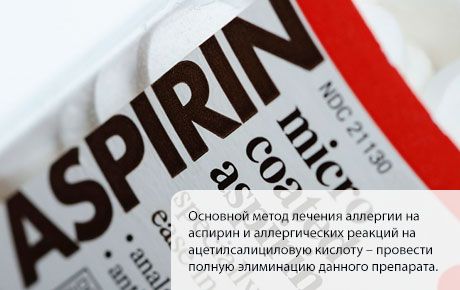Medical expert of the article
New publications
Aspirin allergy
Last reviewed: 08.07.2025

All iLive content is medically reviewed or fact checked to ensure as much factual accuracy as possible.
We have strict sourcing guidelines and only link to reputable media sites, academic research institutions and, whenever possible, medically peer reviewed studies. Note that the numbers in parentheses ([1], [2], etc.) are clickable links to these studies.
If you feel that any of our content is inaccurate, out-of-date, or otherwise questionable, please select it and press Ctrl + Enter.

Acetylsalicylic acid, also known as aspirin, is one of those medications that are widely and long-term used for diseases characterized by inflammation and pain syndromes.
Today it is known that aspirin leads to bronchial asthma (it becomes its cause in 10% of cases); urticaria (0.3% probability), with chronic urticaria in 23% of cases a relapse develops.

Allergy to aspirin also develops in patients with: atopy, female gender, if the HLA phenotype includes the DQw2 antigen and the frequency of the HLA antigen DPBI 0401 decreases.
Signs of an Aspirin Allergy
The following symptoms are considered to be clinical manifestations of aspirin allergy:
- the presence of anaphylactoid reactions, which can be caused by drugs such as zomepirac, tolmetin, diclofenac;
- the presence of rhinoconjunctivitis and bronchial asthma - in chronic eosinophilic rhinosinusitis, when there are some or no nasal polyps, and also if there is a secondary purulent infection; in asthma, most often severe and corticosteroid-dependent. The classic triad is the presence of rhinitis accompanied by nasal polyps, bronchial asthma and sensitivity to aspirin;
- the presence of skin manifestations - chronic urticaria, angioedema, isolated periorbital edema, Lyell's syndrome (with fenbrufen, indomethacin, piroxicam); purpura (with phenylbutazone, salicylates); photodermatitis (with naproxen, piroxicam, tiaprofenic acid, benoxaprofen);
- the presence of hematological manifestations - eosinophilia, cytopenia;
- with respiratory manifestations - pneumonitis (with fever, cough, pulmonary infiltrates). They are observed when the patient is sick with arthritis (its different types) and usually when naproxen, sulindac, ibuprofen, azapropazone, indomethacin, piroxicam, phenylbutazone, oxyphenylbutazone, diclofenac are used.
The clinical plan is described by a new triad: atopy, sensitivity to non-steroidal anti-inflammatory drugs, and the development of anphylaxis if exposed to house dust (airborne allergen).
Respiratory symptoms associated with aspirin allergy:
- presence of suffocation;
- presence of asthma attacks;
- presence of shortness of breath;
- wheezing.
- tingling in the lungs.
Digestive system symptoms associated with aspirin allergy:
- the gastrointestinal tract is not functioning properly;
- periodic or persistent stomach upset;
- excrement becomes light in color;
- the presence of colic in the navel area;
- the patient suffers from heartburn;
- dryness and bitterness in the mouth;
- unintentional burps.
- increasing the threshold of the gag reflex;
Symptoms of the nervous system in case of allergy to aspirin:
- the patient suffers from headaches, including migraines;
- blood pressure increases;
- the back of the head goes numb;
- the patient feels dizzy;
- the appearance of whistling in the ears;
- presence of general fatigue;
- apathy;
- body temperature rises;
- the color of the skin changes;
- red spots appear on the patient's body, and they peel slightly around the circumference;
- primary stage of urticaria.
Diagnosis of aspirin allergy
When experts tried to identify an allergy to aspirin using skin testing, this method was ineffective (IgE antibodies to platelet antigens, salicyloyl and O-methyl-salicyloyl were affected).
To qualitatively diagnose hypersensitivity to aspirin, as well as nonsteroidal anti-inflammatory drugs, it is ideal to use a controlled oral provocation test. To do this, you need:
If aspirin urticaria is suspected:
On the first day, take a placebo; on the second day, one hundred, two hundred milligrams of aspirin; on the third day, three hundred twenty-five milligrams, then six hundred fifty milligrams of aspirin. At the same time, monitor urticaria (check every two hours to see how many are present).
If a patient is suspected of having aspirin-induced rhinosinusitis/bronchial asthma:
Application plan: on the first day, at eight o'clock in the morning, take a placebo, the same at eleven o'clock in the morning and two o'clock in the afternoon; on the second day, in the morning at eight o'clock - thirty milligrams of aspirin, sixty milligrams at eleven o'clock and one hundred milligrams at two o'clock in the afternoon; on the third day - one hundred and fifty milligrams of acetylsalicylic acid at eight o'clock in the morning, three hundred and twenty-five milligrams at eleven o'clock and six hundred and fifty milligrams at two o'clock in the afternoon. Even when patients had hypersensitivity, 86% of them had a decrease in FEV1 by more than 20% (development of bronchoconstriction was observed) and/or naso-ocular reactions appeared.
An inhalation provocation test is also effective, when lysine-acetylsalicylic acid is used. Experts say that it is easy to perform, and the bonus is that there are no bronchoconstrictive reactions. Lysine-acetylsalicylic acid conjugate powder is dissolved in water 11.25 mg, 22.5 mg, 45 mg, 90 mg, 180 mg, 360 mg.
Who to contact?
Treatment of aspirin allergy
The main method of treating hypersensitivity to aspirin and allergic reactions to acetylsalicylic acid is to completely eliminate this drug.
Sometimes desensitizing measures are used:
- when the inflammatory process in the respiratory tract is uncontrolled, although adequate therapy is carried out (using local and systemic corticosteroids);
- when repeated surgical treatment of sinusitis is necessary;
- when the patient has arthritis.
With effective desensitization to acetylsalicylic acid, there is a decrease in leukotriene sulfidopeptide derivatives (LTE4).
In patients with aspirin hypersensitivity, there is a high probability that bronchospasm may develop if topical ophthalmic drugs are used (use of keto-rolac, flurbiprofen, siprofen, diclofenac).
Aspirin allergy is one of the most common types of drug allergy. Diagnosis and treatment of aspirin allergy are not particularly difficult.


 [
[